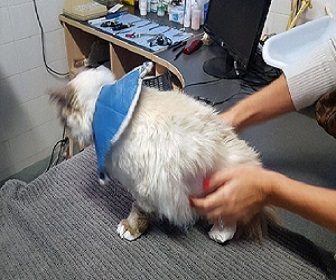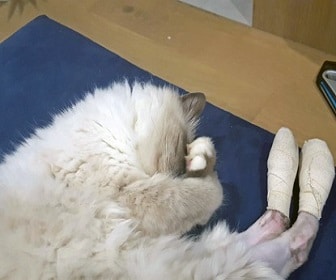 It has always been said that cats always land on their feet. Unfortunately, this isn’t necessarily true all the time. Cats topple in undignified heaps after ill-advised attempts to scale bookshelves or jump onto magazine-covered tables, which inevitably sends them skidding like children at playtime.
It has always been said that cats always land on their feet. Unfortunately, this isn’t necessarily true all the time. Cats topple in undignified heaps after ill-advised attempts to scale bookshelves or jump onto magazine-covered tables, which inevitably sends them skidding like children at playtime.
If you’re a watcher of cat videos – and really, who isn’t? – then you know that cats are not always the graceful creatures they pretend to be. Usually, though, they compensate quite quickly, bouncing to their feet in the blink of an eye, with a challenging stare for anyone who even thinks about laughing at them.
Poor Mozart the cat wasn’t able to recover so quickly from his nearly 100-foot fall from his human’s balcony. Martin Orliac was about halfway through the new Star Wars movie when he received a text message saying that his cat had fallen from the balcony and had had to be taken to the animal hospital. Orliac rushed over to the hospital to find Mozart with both of his hind legs broken; according to the vet, it was a miracle that he had survived.
While the pretty long-haired cat would recover from his injuries, he wouldn’t be able to walk for about two months. The vet suggested a small enclosure and an expensive wheelchair, but Orliac had an idea that would be kinder to both his cat and also to his budget.
“These wheelchairs for pets are really expensive, ad hoc-type devices that cost dramatically more than for a human,” he said. “But some people have been quite ingenious in making wheelchairs for cats. A guy in Israel made different parts through 3D printing and put them readily available online. It wouldn’t cost much and wouldn’t be that difficult, but I didn’t have a 3D printer.”
Orliac’s friend Joshua Flannery is an entrepreneurship catalyst at the University of New South Wales, and when Orliac told him about Mozart’s situation, he put out a call to his fellow students. It was only a few days before Christmas, and Flannery almost immediately received numerous responses from people who were eager to help Mozart get back on his feet for the holidays. Viriya Chittasy, a student who owns a 3D printer, printed the parts necessary to assemble a new kind of kitty wheelchair, which he then presented to Orliac.
Mozart took to his wheelchair ,immediately walking, running and even jumping. According to Orliac, the cat has even gotten a bit bored with it. Luckily, he’ll be able to use all four of his legs again in just a couple months, although as we’ve seen with many other crippled animals, the wheelchair could suit him for life if he needed it.
“It’s amazing what innovation can deliver,” Orliac said.
Flannery was thrilled with the immediate, caring response from his fellow student entrepreneurs, who were just eager to use technology to help his friend.
“It was important to be able to give back to our partners on a more personal level and it just shows that we have a really caring and valuable community of entrepreneurs around the university,” he said.
So while Mozart may not have been able to bounce back to his feet as quickly as he would have from minor fall, the fact that he has been able to move around normally at all is a remarkable demonstration of how easy it has become to help disabled animals through 3D printing.
Many articles about wheelchairs and prosthetics for animals have been written; a quick perusal through any of them shows that 3D printing technology has become a sort of savior for more than just humans.

To give those of you a look at these “wheelchairs” for cats in action, here is a video of another cat named Benji … Benji is a disabled kitten, who is paralyzed in from the waist down. He’s a happy, playful kitten who just wants to have fun all day long, and tries to make the most of every situation despite his disability:
Read these characteristics which almost all cat lovers have in common:
INTROVERTED AND SENSITIVE
It’s the nature of cats that they are not friends with everybody, and the same trait can be seen in their owners too. Usually, they live alone and are happy with their independent lifestyle. They are introverts but are comfortable hanging around with other people. However, they would need some me-time to relax and recharge.
CAT LOVERS LEAN TO LEFT
It has been observed that people with liberal political leanings prefer cats over dogs. You might be a liberal dog lover or a conservative cat owner; if you’re a liberal, you love cats and vice versa.
CAT OWNERS ARE OPEN-MINDED
Five traits – conscientiousness, neuroticism, extraversion, agreeableness, and openness are often seen in most cat lovers. As compared to dog owners, people who have cats as pets are more open and therefore, have greater artistic creativity.
ATTENTION SEEKERS
Just like their pets, cat lovers seek attention from people around them. They like to be the centre of all conversations. At times, cat owners rely on their pets for emotional support.
THEY RESPECT CATS MORE THAN ANYONE
Cat people respect cats more than humans, in general. The saddest sight for a cat lover is to see the animal on the streets without a home. Cat lovers are often seen making a special effort to rescue or rehabilitate homeless cats.